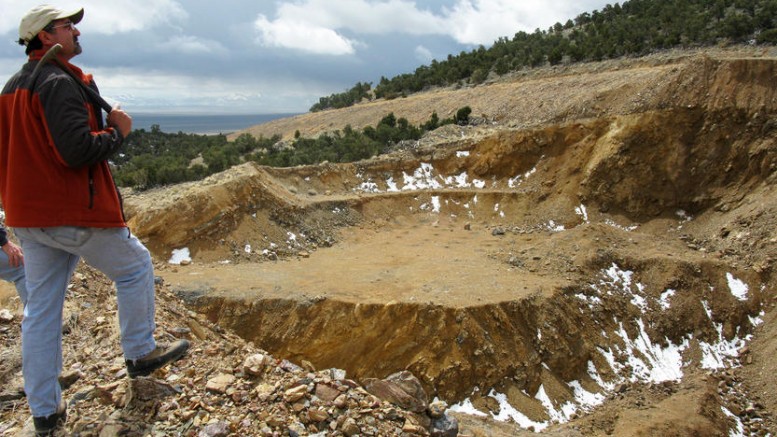VANCOUVER — A 36.6-metre intercept grading 8.53 grams gold per tonne has Pilot Gold (TSX: PLG; US-OTC: PLGTF) convinced anew the Kinsley Mountain project in Nevada could contain a lot of gold.
Kinsley Mountain had already seen more than 1,300 drill holes when Pilot arrived on scene, but Pilot’s team had something previous operators did not: expertise from discovering the nearby 2.6 million oz. Long Canyon deposit. When Pilot combined that expertise with data from all those historic holes, the result was an exploration model with clear target areas.
“What that model told us is that we should be looking to the north of the mine, to the east and to the west,” said Matt Lennox-King, Pilot’s president and CEO in an interview. “The results . . . really confirm for us that this predictive model we came up with is in fact predictive, and that we can vector in on high-grade structures.”
The new high-grade hit came in hole 91, which returned 36.6 metres grading 8.53 gram gold from 232 metres depth. The hole probed the Western Flank, an area northwest of Kinsley’s historic open pits. Nearby holes also encountered gold: hole 74 cut 24.4 metres grading 1.65 grams gold from 145 metres depth, hole 83 intercepted 3 metres grading 15.6 grams gold from 111 metres downhole, hole 73 cored 10.7 metres of 2.21 grams gold from 271 metres downhole, and hole 102 returned 16.8 metres grading 2.51 grams gold from 88 metres depth.
Pilot had pulled a few high-grade hits from Kinsley since acquiring the project in 2011, but most of its drilling has returned long, lower-grade intercepts. The Long Canyon district often offers such a mix.
“What we had been drilling to date at Kinsley was been mostly the lower-grade, disseminated style of mineralization,” he said. “The holes . . . confirm for us that we do have that tight, structurally controlled high grade as well, and to us that’s the important thing.”
Lennox-King noted the drill cores showed gold in a different stratigraphy and in different structures than previously encountered. Prior operators believed gold at Kinsley was restricted to a set of northwest-trending structures, and the Candland shale unit.
Pilot’s latest holes prove this wrong: drills hit into high-grade gold along north- and northeast-trending structures and into lower-grade gold in a unit of silty limestone beneath the Candland shale. In addition, Pilot has found gold at Kinsley in two other stratigraphic units, specifically the two limestone units that are the primary gold hosts at Long Canyon.
“It tells us that we have good host rocks in four different stratigraphic horizons,” Lennox-King said. “And four is better than one.”
Kinsley is a historic mine that produced 138,000 oz. gold from oxidized ores, mined out of shallow pits. The project is located 80 km southeast of Long Canyon, the flagship discovery that enticed Newmont Mining (TSX: NMC; NYSE: NEM) to take over Fronteer Gold in 2011. Pilot Gold was spun out of that deal to hold Fronteer’s 14 other properties. Most of Fronteer’s management and technical personnel moved to the new vehicle as well.
The company had been limited to one drill at Kinsley until late August, when the U.S. Bureau of Land Management approved a plan of operations permit for the site. Since then Pilot has had two or three drills turning at the project. Lennox-King lauded his team for their accomplishments in that time.
“When you’re dealing with structurally controlled things like this, sometimes vectoring in can take time,” he said. “You have to work your way in from the halo. When you do get into it, though, it’s exciting and rewarding. It feels like we’re really onto something.”
Pilot Gold owns 78% of Kinsley. A subsidiary of Nevada Sunrise Gold (TSXV: NEV; US-OTC: NVSGF) holds the other 22%, its stake having declined from 35% this year because of its decision to not contribute to this year’s exploration budget, which was reduced to $3.4 million.
Pilot’s other project is TV Tower, a large land package in northwest Turkey where extensive hydrothermal alteration created an array of gold, copper and silver targets. Pilot has a 40% stake in TV Tower but acts as project operator, pursuant to a deal that is also helping the company boost its stake to 60%, by funding $21 million in exploration over three years. Teck Resources (TSX: TCK.B; NYSE: TCK) is Pilot’s partner at the project.
Pilot has indeed been spending money at TV Tower over the last two years, and has only $7.1 million left to spend to vest its 60% stake. The company has enough funds to spend that much next year, with US$24 million cash-on-hand at the end of September.
On news of the Kinsley results, Pilot shares gained 7¢ to 91¢. Shares have a 52-week range of 71¢ to $2.40, with 90 million shares outstanding.


Be the first to comment on "Pilot Gold finds high-grade structures at Kinsley"